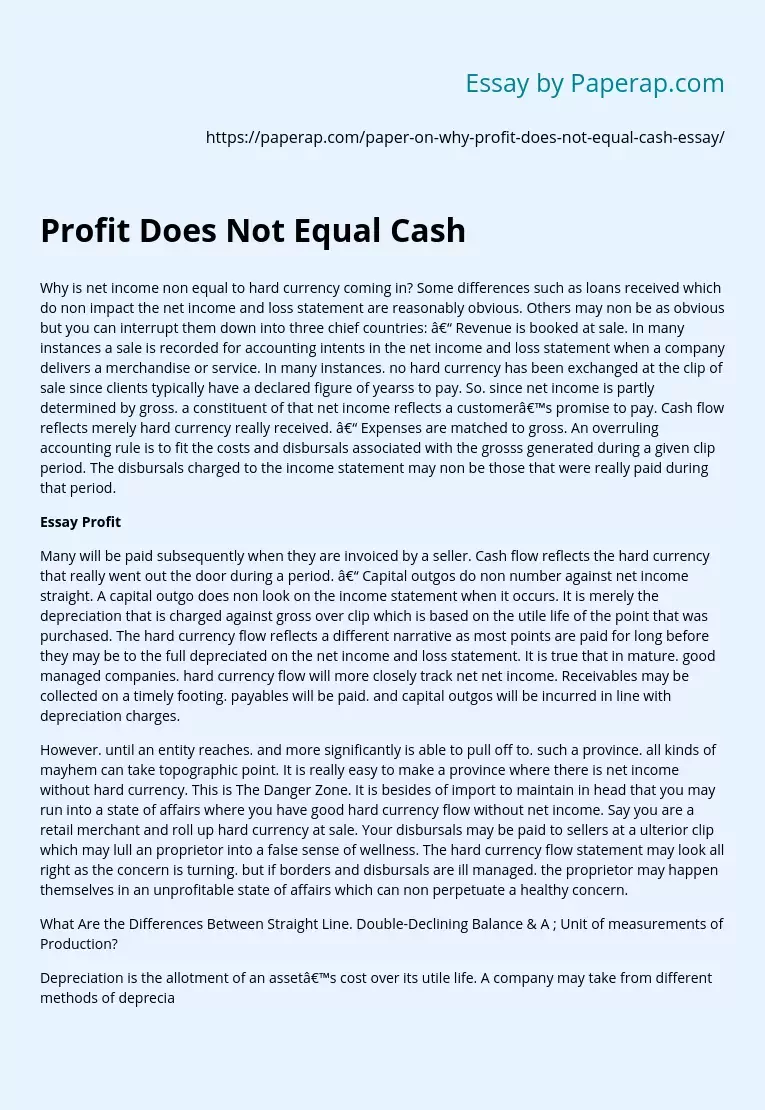Profit Does Not Equal Cash
Why is net income non equal to hard currency coming in? Some differences such as loans received which do non impact the net income and loss statement are reasonably obvious. Others may non be as obvious but you can interrupt them down into three chief countries: Revenue is booked at sale. In many instances a sale is recorded for accounting intents in the net income and loss statement when a company delivers a merchandise or service.
In many instances. no hard currency has been exchanged at the clip of sale since clients typically have a declared figure of yearss to pay.
So since net income is partly determined by gross a constituent of that net income reflects a customer’s promise to pay. Cash flow reflects merely hard currency really received. Expenses are matched to gross. An overruling accounting rule is to fit the costs and disbursals associated with the grosss generated during a given clip period. The disbursals charged to the income statement may non be those that were really paid during that period.
Many will be paid subsequently when they are invoiced by a seller. Cash flow reflects the hard currency that really went out the door during a period. Capital outgos do non number against net income straight. A capital outgo does non look on the income statement when it occurs. It is merely the depreciation that is charged against gross over clip which is based on the utile life of the point that was purchased.
The hard currency flow reflects a different narrative as most points are paid for long before they may be to the full depreciated on the net income and loss statement.
It is true that in mature. good managed companies. hard currency flow will more closely track net net income. Receivables may be collected on a timely footing. payables will be paid. and capital outgos will be incurred in line with depreciation charges.
However. until an entity reaches and more significantly is able to pull off to such a province all kinds of mayhem can take topographic point. It is really easy to make a province where there is net income without hard currency. This is The Danger Zone. It is besides of import to maintain in head that you may run into a state of affairs where you have good hard currency flow without net income. Say you are a retail merchant and roll up hard currency at sale.
Your disbursals may be paid to sellers at a ulterior clip which may lull an proprietor into a false sense of wellness. The hard currency flow statement may look all right as the concern is turning. but if borders and disbursals are ill managed. the proprietor may happen themselves in an unprofitable state of affairs which can non perpetuate a healthy concern.
Depreciation is the allotment of an asset’s cost over its utile life. A company may take from different methods of depreciation for fiscal coverage intents. Straight line. double-declining balance and units of production are three such methods. Each method differs in the manner it allocates an asset’s cost. which can impact your little business’ net income.
Purpose of Depreciation
Accrual-based accounting requires a concern to fit the disbursals it incurs with the grosss it generates each accounting period. Because a long-run plus. such as a piece of equipment contributes toward grosss over many accounting periods. a company spreads the asset’s cost over its utile life utilizing depreciation. This creates a depreciation disbursal on the income statement each accounting period equal to a part of the asset’s cost alternatively of making an disbursal for the full cost all at one time.
Timing Differences
Each method of depreciation depreciates an plus by the same overall sum over the asset’s life. but each method does so on a different agenda. The straight-line method depreciates an plus by an equal sum each accounting period. The cut downing balance method allocates a greater sum of depreciation in the earlier old ages of an asset’s life than in the ulterior old ages.
Different Uses
A concern chooses the method of depreciation that best lucifers an asset’s form of usage in its concern. A company may utilize the straight-line method for an plus it uses systematically each accounting period. such as a edifice. Reducing balance may be appropriate for an plus that generates a higher quality of end product in its earlier old ages than in its ulterior years/ loss efficiency.
Different Effectss on Net income
Depreciation disbursal reduces a business’ net income on its income statement. While the straight-line method reduces net income by the same sum each accounting period. the other two methods cause a company’s net income to fluctuate with all else being equal. The double-declining-balance method causes lower net income in the earlier old ages of an asset’s life than in the ulterior old ages due to the greater depreciation disbursal in the earlier old ages. Units-of-production may do unpredictable net income swings based on the sum of end product an plus generates.
Profit Does Not Equal Cash. (2019, Dec 05). Retrieved from https://paperap.com/paper-on-why-profit-does-not-equal-cash-essay/

